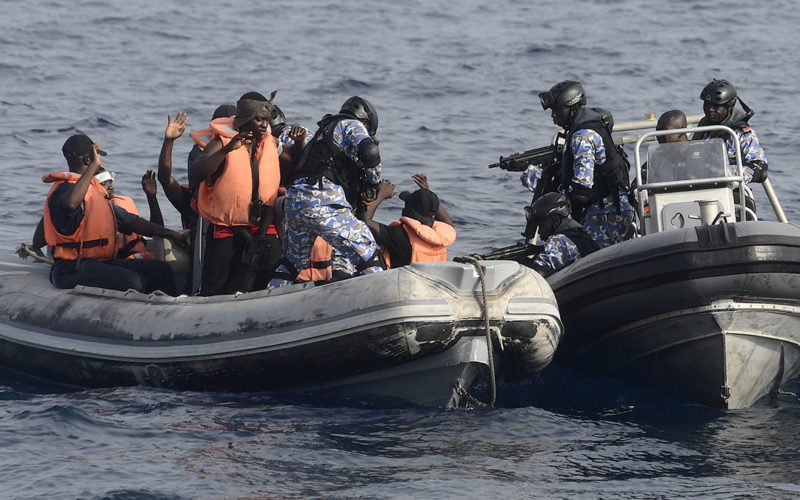
Although COVID-19 slowed most maritime activity in 2020, piracy did not face a slump.
In its annual piracy report, the International Chamber of Commerce’s International Maritime Bureau (IMB) tallied 195 reported incidents of armed robbery against ships worldwide, up from 162 reported in 2019. Much of the activity occurred in Africa’s Gulf of Guinea, which is the site of a disturbing proliferation of crew kidnappings.
“It’s become a business,” said Michael Howlett, director of the IMB. “They are taking off whole complements of crew and then taking them back on land. They are showing greater capability and attacking farther from the coast.”
In the Gulf of Guinea, there were 82 piracy incidents in 2020, according to the report. In 22 of them, the attackers, usually armed with guns, kidnapped crewmembers. One hundred thirty people were abducted this way. After a kidnapping, crews are typically held on land until their release is negotiated. Last year, the periods of captivity lasted up to six weeks.
The report warned that all types of vessels were targeted for kidnappings. On average, kidnappings occurred 60 nautical miles from shore, but the farthest was 200 nautical miles.
There were no murders as a result of these attacks, but on Jan. 23, 2021, pirates killed a crewmember and abducted 15 others after boarding a Turkish-flagged containership in the Gulf of Guinea.
Most pirates in the gulf come from the Niger Delta, where poverty and unemployment remain high despite a vast petroleum industry. Around 2005, a coalition of insurgent groups emerged, demanding a greater share of oil revenue and carrying out attacks on pipelines and other infrastructure. Buoyed by knowledge of seafaring industries and local geography, and angered at not receiving more material benefit from the oil industry, many militants became pirates.
“This insurgency/piracy nexus often exists among different kinds of organized crime,” states “The Anatomy of Gulf of Guinea Piracy,” a paper published by the U.S. Naval War College. “In the Gulf of Guinea, however, piracy is committed with impunity and insurgents, rather than achieving a symbiotic relationship with pirates, have fully transformed into pirates themselves.”
In recent years, ransom has replaced theft as their business model. “Before, pirates were satisfied with taking ropes, paint and some valuables from ships,” Fabrizio Barcellona, a section coordinator for the International Transport Workers’ Federation, told Professional Mariner. “Now they are often determined to take seafarers hostage in the hopes of lucrative release payments. Their attempts at capturing seafarers often go wrong and leave parties on both sides injured or dead.”
The IMB advised ships in the Gulf of Guinea to stay at least 250 nautical miles from shore when not transporting cargo. Howlett also called for better, more coordinated security measures among the eight countries that border the gulf. These countries don’t allow the naval forces of another to enter their waters.
“The Gulf of Guinea is very complex and there are a lot of sensitivities,” Howlett said. “(Countries) need to be more focused on initiatives for greater information-sharing.”
Another region experiencing an increase in pirate attacks is the Singapore Strait, where 23 incidents occurred in 2020, according to the IMB. The attacks were mostly armed thefts conducted from vessels under the cover of darkness. The number of incidents in the region nearly doubled from 12 in 2019.
The report warned mariners to be vigilant in those areas. However, the number of incidents in 2020 was comparable to other recent years — the IMB tallied 201 pirate attacks in 2018 and 191 in 2017 — and the overall global piracy situation is remarkably better since the Somali pirate crisis of a decade ago. In 2010, the IMB gathered 445 reports of attacks, about half of which were by Somali pirates, and 1,181 crewmembers were taken hostage that year. In 2020, no piracy reports came from the Somalia region.
Barcellona cited the resolution of the problem there as a model for the Gulf of Guinea.
“The international community was able to deploy an international naval force around the coast of Somalia, where patrols and enforcement slowly but surely managed to reduce attacks on ships to nearly zero,” he said. “However, unlike in Somalia, local governments in the gulf do not allow external naval forces into their waters, or (allow) merchant vessels to have private, armed security guards on board. As long as these governments block other solutions, they must lift their game to combat this rising threat.”
Piracy update for the Americas
With 30 piracy and armed robbery incidents recorded in South American, Central American and Caribbean waters in 2020, the International Maritime Bureau’s five-year statistics show no sign of improvement for this region.
The beginning of 2020 came with a warning about a maritime threat in the southern Gulf of Mexico. The nature of the threat was four piracy incidents that took place between April 4 and April 15, all involving attacks on offshore supply vessels. Some of the incidents involved crew injuries and theft.
While the IMB recorded no additional incidents in the Gulf of Mexico in 2020, media have described a steep increase in the number of attacks on maritime oil infrastructure in Mexico since 2016 — including an average of 16 attacks a month between January and September 2019, according to some reports. Although these numbers are unconfirmed, they suggest that there could be a significant degree of under-reporting of incidents in the gulf.
The Callao Anchorage in Peru has been regarded as a robbery hot spot for many years and 2020 was no different, with eight incidents recorded (two less than in 2019). However, an alarming new trend is the increase in robberies in Brazil near Macapa City at the mouth of the Amazon River. Seven incidents were reported in this area in 2020, a trend that continued into January 2021.
Gard marine insurance

